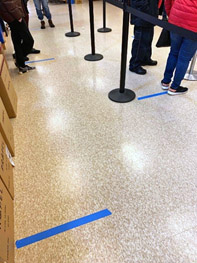The Novel Coronavirus (COVID-19) led the Tsoi Kobus Design team to consider how lessons emerging from social distancing, creating emergency healthcare spaces, and providing care for the varied and vast patient population will impact future healthcare facility design. In light of the changing expectations for public health and safety, David Kelly asks the question: How do we "rethink the queue" in our current COVID-19 world, and also plan for the post COVID-19 world?
When healthcare facilities resume normal operations following COVID-19 they must rethink how patients, visitors, and staff are received to guarantee safety with an increased focus on cross contamination issues. Tsoi Kobus Design has experience designing clean and soiled workflows; this cross contamination focus should be further expanded to target not only on materials and equipment movement, but also on people movement in both clinical and public spaces.
 It is inevitable that individuals will need to queue up to maintain orderly and efficient patient flows and future queuing spaces must be designed to maintain social distancing to avoid cross contamination. Queues will require an expanded purview from local Boards of Health to maintain effectiveness. Visual cues should be employed, including signage, floor and wall markers, to ensure that proper social distancing measures are met. Additional protective measures could be implemented, such as a "sneeze guard" typically used in food services, which have been recently installed in grocery stores.
It is inevitable that individuals will need to queue up to maintain orderly and efficient patient flows and future queuing spaces must be designed to maintain social distancing to avoid cross contamination. Queues will require an expanded purview from local Boards of Health to maintain effectiveness. Visual cues should be employed, including signage, floor and wall markers, to ensure that proper social distancing measures are met. Additional protective measures could be implemented, such as a "sneeze guard" typically used in food services, which have been recently installed in grocery stores.
The sketch below is based on my experience at a New Bedford Fish Market during the COVID-19 mandated social distancing. The market maintained the 10-person limit — four employees and six customers at a time. I arrived at the market just after it opened and customers had queued up, then quickly and collectively agreed to adjust the queue to eliminate crossing paths.
Circulation plans are a critical factor in designing for healthcare institutions. New plans arising from the COVID-19 crisis will provide a solid foundation for a strategic rethinking of patient flows to be applied when designing facilities where there is a tendency for patients to queue. This new learning curve will set the standard for facilities of the future in the post COVID-19 world.


